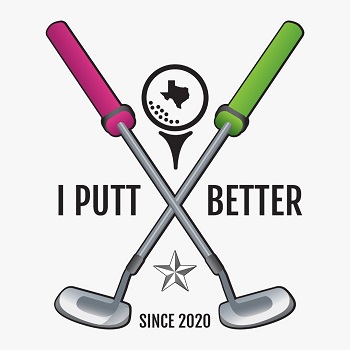Become a pro in Days!
How to use Delta Putt golf training device
The Delta Putt is a golf putting training device designed to give you instant feedback on your stroke path and putter face position at impact. It can be used anywhere, anytime on any flat surface from putting greens to carpet, hardwood, linoleum, and synthetic practice mats.
Use The Delta Putt at home, your office, when you travel, or on the practice green before your round to confirm your perfect address and ball position to create a consistent, repeatable putting stroke on the course.
By observing how the puck tracks down the mat you’ll see and feel if your stroke was outside-in, inside-out, or straight down your intended line by where the protrusion on the puck (back of the “ball”) finishes in relation to the center stripe on the mat. You can then make subtle adjustments in your ball position at the address until you’re stroking the “ball” straight down your intended line.
The following photos show the Stroke Path of a right-handed golfer. If you’re a “lefty” you know what to do!
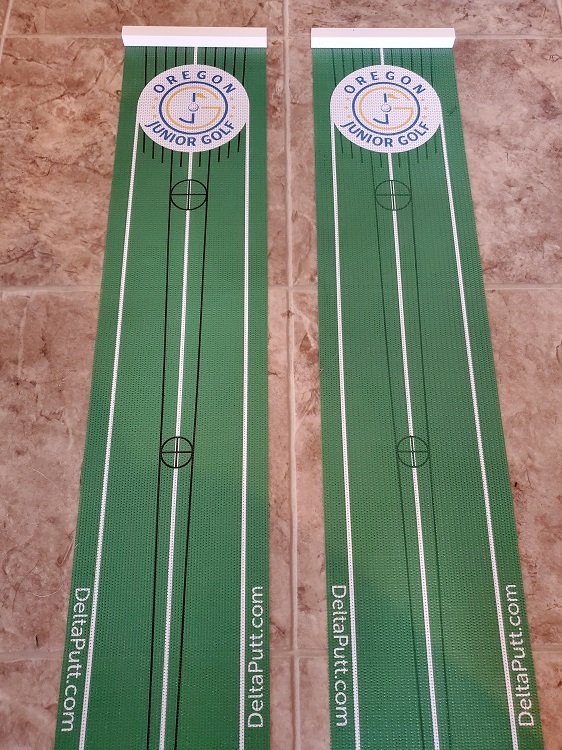


Outside-in, Inside-out and Straight Stroke Paths.
How the puck reacts is a direct result of how the puck was struck. Basic physics, “if you do this, the puck does that.” The puck does not lie. It gives instant feedback that allows you to make adjustments in your set-up position, grip, and stroke so you can begin developing a consistent, repeatable putting stroke by building muscle memory, visual and kinesthetic sense to know exactly when you are in perfect address position to make a perfect stroke every time. Should you find that your stroke path is consistently left off the centerline, your stroke path is “outside-in” as shown in the photo above.
How to correct outside-in stroke path
Start by positioning the puck slightly further back in your stance. After each adjustment of moving the puck back in your stance (towards your right foot), take a few strokes to see if that adjustment is keeping the puck closer to the center intended line. If it has, repeat, repeat, repeat so you will get accustomed to the new “ball,” (puck) position. If after making a ball position adjustment you are still pulling the puck left of the centerline, try moving your address position slightly further away from the “ball” (puck). Make sure that when you look down at the ball, your eyes are directly over the ball or slightly inside of the ball. If your eyes are outside the ball, it is virtually impossible to do anything but “pull” the ball left of the center, intended line.
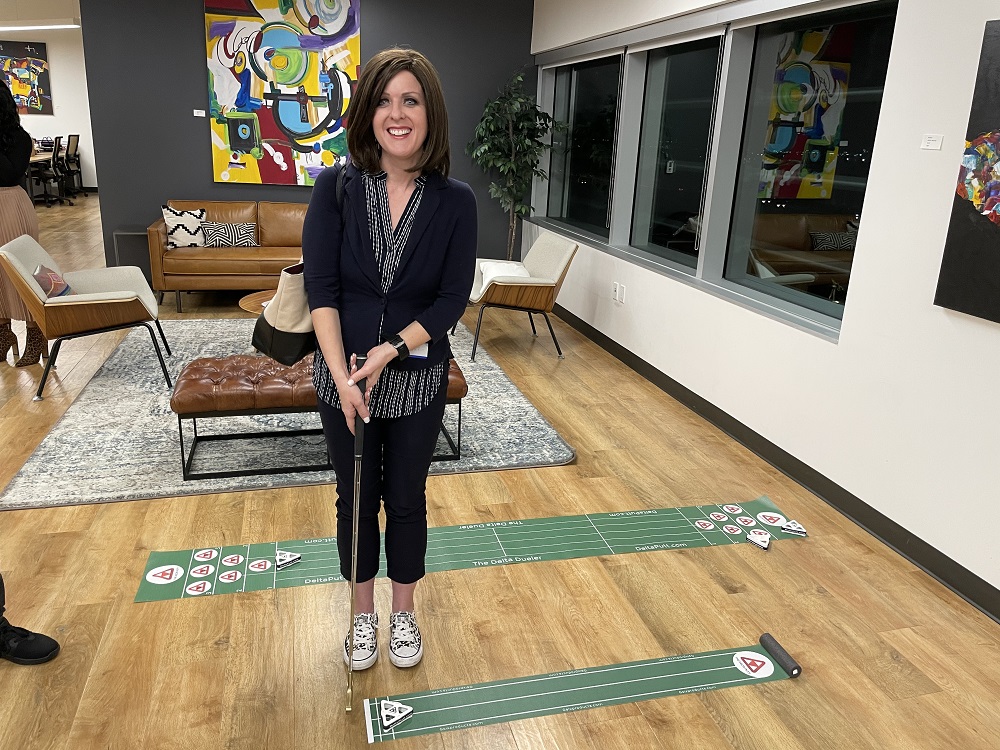

How to correct inside-out stroke path
Start by positioning the puck slightly further forward in your stance. After each adjustment of moving the puck forward in your stance (towards your left foot), take a few strokes to see if that adjustment is keeping the puck closer to the center intended line. If it has, repeat, repeat, repeat so you will get accustomed to the new “ball,” (puck) position. If after making a ball position adjustment you are still pushing the puck right off the centerline, try moving your address position slightly closer to the puck. Make sure that when you look down at the ball, your eyes are directly over the ball. If your eyes are too far inside the ball, it is virtually impossible to do anything but “push” the ball right of the center, intended line. The great thing about using the Delta Putt is you can experiment with making small adjustments and then instantly
see what the result is immediately after you make the adjustment. If you’re making progress, keep making small adjustments until your stroke path consistently tracks the puck straight down your intended line. Once your stroke path is consistently tracking the puck down your intended centerline, repeat, repeat, repeat until your set-up, routine becomes automatic. You will be amazed how this will transfer from the practice mat to the golf course.
Get The Perfect Putt
Next, we will observe where the leading point of the triangle finishes in relation to the stroke path. If the leading point rotates left of the stroke path, the putter face was “closed” at impact. (Toe ahead of the heel.) If the leading point rotates right of the stroke path, the putter face was “open” at impact. (Heel ahead of the toe.) The goal is to have the leading point remain centered on the centerline having not rotated left or right along with a straight stroke path. This would be a perfect putt, stroke path straight down the intended line, and putter face square at impact. In the next three photos, you will see how the puck reacts with a straight stroke path, but with a Closed, Open, and Square putter face at impact.
Straight Stroke paths with…
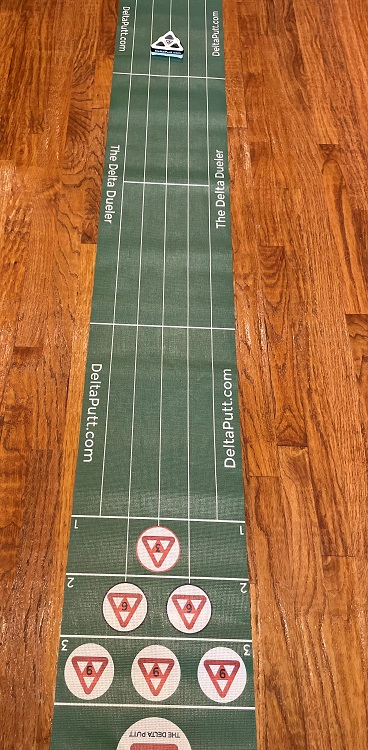

Closed Putter Face Open Putter Face Square Face – perfect!

Once your stroke path is consistently tracking the (ball) protrusion of the puck straight down your intended line, observe where the leading point of the triangle puck is pointed. The more rotation of the leading point, the more “closed” or “open” your putter face was at impact. In the above “closed putter face” photo, should you consistently be seeing the puck in this position after making several putts, experiment by “weakening” your grip slightly. (Rotate and reposition your grip on the putter slightly to the left, counterclockwise at address.)
Take a few strokes and see if this gets the leading point to track straight down the line. Keep making slight grip adjustments until you are tracking the leading point straight down the intended centerline. In the above “open putter face” photo, should you consistently be seeing the puck in this position after making several putts, experiment by “strengthening” your grip slightly. (Rotate and reposition your grip on the putter slightly to the right, clockwise at address.) Take a few strokes and see if this gets the leading point to track straight down the line. Keep making slight grip adjustments until you are tracking the leading point straight down the intended centerline.
Again, the great thing about using the Delta Putt is you can experiment making small adjustments and then instantly see what the result is immediately after you make the adjustment. Once you understand what it takes to develop a straight stroke path with a square putter face at impact using The Delta Putt, you are well on your way to becoming a great putter.
Putting is an art form consisting of athleticism, touch, feel vision, balance, perception, and a host of other sensory skills. Are people born great putters? Maybe a few people are…I believe you can become a great putter by developing a consistent routine where you learn to set up the same way every stroke and apply the basic principles that we just briefly touched upon. There are no two tour pros that putt the same way.
Each has their own style, grip, set-up, stance, and approach to putting yet they all would unanimously agree…if you can start every putt straight down your intended line for the first four feet with a square putter face, your percentage of made putts increases dramatically. The Delta Putt will help any golfer, regardless of skill, do just that.
General Thoughts and observation
While everyone has their own style of putting, there are certain aspects of putting that will destroy consistency. If you find that while using The Delta Putt the puck is tracking all over the mat in different directions, go through this checklist of things that cause inconsistency in your putting stroke.
1. Head Movement.
Your head must remain still throughout your stroke. To help you achieve this, try focusing on the back of the protrusion where your putter impacts the puck. You can use a Sharpie to mark a dot that is a focal point to help keep a steady head. You can do the same thing with your golf balls to focus on the dot out on the course. Give it a try.
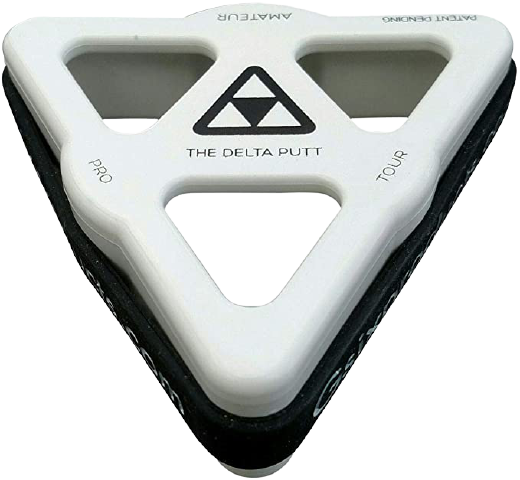
2. Leg Movement.
Keep your legs motionless. Unlike the full swing, the putting stroke requires absolutely no leg motion. Even the slightest amount of leg action will cause inconsistency in your stroke. A good drill to check if you have any leg motion is to back up to a wall so that your rear end touches the wall. Take a few full putting strokes and you will immediately feel any leg motion in your rear against the wall. If you feel leg movement, try shifting 60% to 80% of your weight onto your left leg throughout the stroke. You may find it helps stabilize you.
3. Flippy Wrists:
Keep your wrists stable throughout your putting stroke. Especially on the forward stroke through impact. The head of your putter should never get ahead of your hands throughout the putting stroke.
Please visit our Blog for more tips, tricks, and instructional videos, and Contact Us if you have questions or requests regarding the Delta Putt. Cheers to improved putting
Paul Russo
